Introducing the latest myCWT product and service enhancements
Building on our digital, omnichannel myCWT platform, our new products and services will simplify travel management for you and your employees – anytime, anywhere, anyhow.
Note: Featured services may not be available in your country at this time. Please reach out to your CWT representative for more details.
Hear from Chief Product Officer, Erica Antony as she shares the key product highlights of 2024, along with the key areas driving innovation.
-
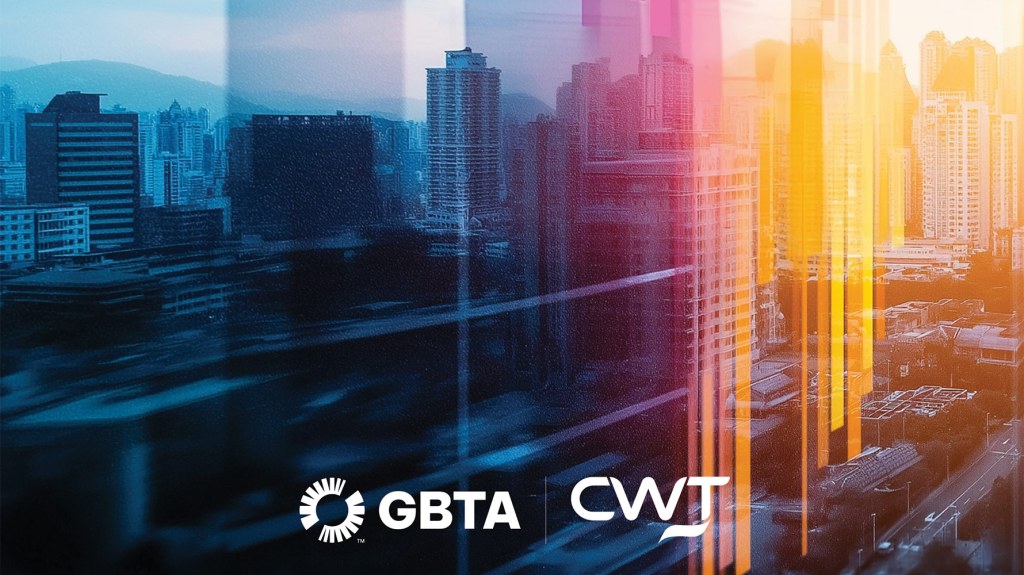
2040: Baseline, Boom or Bust
As we enter an era of rapid transformation and unprecedented challenges, it is essential for travel managers, meeting & event planners, and corporate decision-makers to look ahead and frame our current strategic thinking with a clear vision of the future. Business travel and meetings and events (M&E) are poised for significant change over the next decade and a half, driven by a complex interplay of sustainability goals, technological advancements, evolving work models, and geopolitical dynamics.
In this paper to mark the 10th anniversary of our Global Business Travel Forecast, we explore, for the first time, a long-term vision of the future and potential trajectories through three distinct scenarios, each offering insights into how these forces should affect policy-making, budgeting and priorities. By examining these scenarios, we can better understand the diverse possibilities that lie ahead and the strategic imperatives required to thrive in each potential future.
Based on trajectory data analysis and interviews with industry leaders, behaviorists and climate tech founders, this forward-looking approach enables us to anticipate changes, strengthen our strategies, and make informed decisions that align long-term objectives. It is through this lens of foresight and adaptability that we can build resilience, seize opportunities, and navigate the complexities of the future.
We invite you to reflect on the insights presented, and consider how your organization can prepare for the opportunities and challenges that lie ahead. Together we can ensure that travel and meetings remain catalysts for growth, scalability and sustainable practices.
- Scenario development is both an art and a science
- Megatrends Shaping the Future of Business Travel, Meetings and Events
- Sustainability goals the new crux of corporate policy
- Technology Revolutionizes Travel Management
- Modern work models spark new travel patterns
- Changing demographics open doors to new opportunities
- Three Scenarios: Base case, boom and bust
- Future-proofing strategies

-

CWT GBTA Global business travel forecast 2025
When it comes to pricing, global business travel has finally reached an enduring, higher baseline. Prices will continue to rise in 2025, but only moderately, so expect a period of normalized growth.
However, this pricing environment, one of marginal gains and price regularity, is fragile. Global leisure travel has now realized a lot of its pent-up demand, while corporate travel has been resurgent, with 2024 edging at preCovid levels.
There are many factors at play, whether its volatile oil prices, labor costs and constraints, inflationary pressures, and geopolitical factors. As this elevated baseline edges upwards, albeit marginally, travel budgets will come under increased scrutiny, especially as travel patterns and attitudes change.
It’s why business travel can’t be viewed in a silo, and the true value to an organization must be fully realized. This forecast can help with those calculations.

-

Capitalize on emerging technologies in corporate travel
Technological advancements are accelerating at an unprecedented pace. How will emerging innovations like Generative AI, blockchain, and self-sovereign identity (SSI) transform corporate travel?
BTN and CWT probed global CEOs, travel managers, industry consultants and tech experts on the promises, questions, and expectations these innovations raise and how they are set to reshape traveler experience, cost control and service delivery in corporate travel and events.
Download and discover
- The technologies that will have the greatest impact on corporate travel in the next 2-5 years
- How these emerging technologies are poised to control costs, enhance service and security, and boost efficiency
- The critical challenges, opportunities, risks and roadblocks each innovation raises
- What travel managers, buyers and experts anticipate from these innovations

-

Bridging the digital divide
The Covid-19 pandemic meant that millions of children around the world had to make an instant switch to remote schooling for significant parts of last year, triggering the largest disruption of education systems in recent history. As not all families had sufficient devices to accommodate remote learning, it highlighted thedigital divide like never before.
According to a study by the Pew Research Center, one-in-five parents claimed it was likely their children would not be able to complete their schoolwork because they did not have access to a computer at home (21%), and the lack of a reliable internet connection at home (22%) impacted their schoolwork.
CWT is acknowledging this stark inequality and for the second year in a row has been donating computer equipment to children and their families in underserved communities in Minneapolis, Minnesota, working in partnership with local charity, Minnesota Computers for Schools.
Over 1,500 pieces of computer equipment were dispatched. It took the Minnesota Computers team five hours to load up a truck with laptops, desktop computers, printers, monitors, keyboards, and mice.
The team is thrilled that devices that have surpassed their lifecycle for business purposes are ‘starting a second meaningful life’ enabling children from lower-income backgrounds to continue their education with as little disruption as possible, and ultimately, to realize their full potential. If you’re passionate about helping to close the digital divide in your community, here are three ways to get started.
Band together
Create a group of colleagues or parents & caregivers in your local community who are concerned about the digital divide and learn about the specific challenges being faced. Compile those challenges and personal stories into a list. Use the list and anecdotes gathered to find a solution such as presenting the evidence to local policymakers, starting a donation bank for unused devices, or fundraising for a remote learning charity.
Raise awareness of the need for free WiFi
Consider looking into whether your area can set up free WiFi hotspots or create a free interactive map to share online that lists places with free and safe connectivity.
Volunteer to help increase digital literacy
There are various organizations that help to teach digital skills to people of all ages, from setting up an email account to social media marketing. Your skills can change someone’s prospects. If you can’t find a local charity, consider posting your intention on a local group.
Image credits: Adobe Stock
-
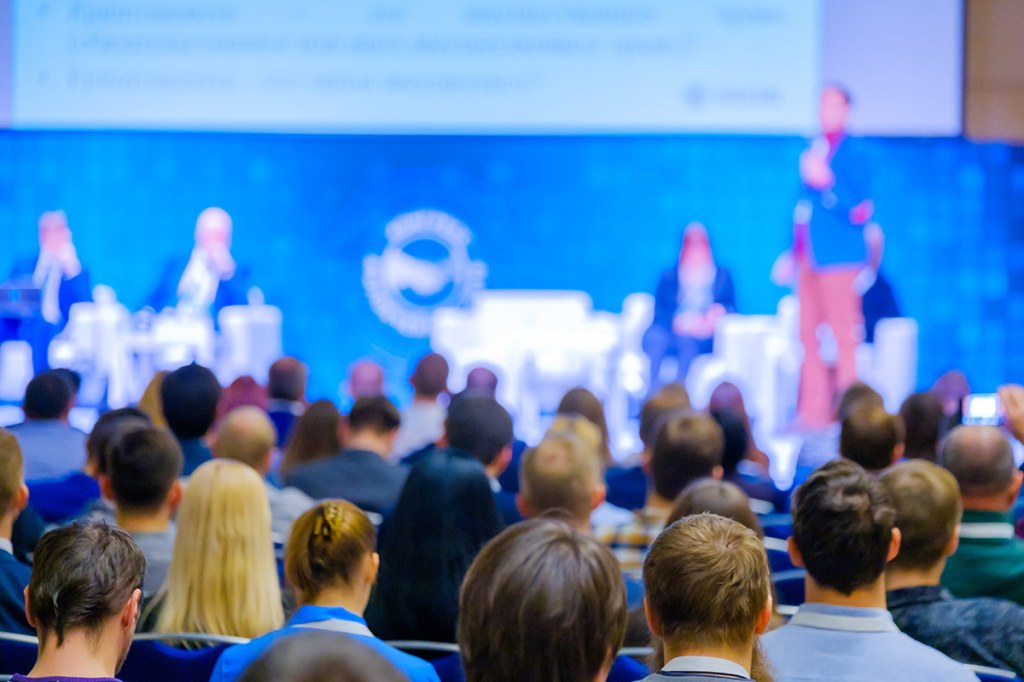
The right lens – When to choose live vs pre-recorded virtual events
There are many factors to take into consideration when deciding to host a live or pre-recorded event but the planning should start with what your overall goals and aims are for you and your attendees.
For live sessions, be considerate of the time zone of the attendees and speakers. Avoid anyone presenting or attending at odd hours of the day and be mindful in a global working environment.
Budget and costs versus return on investment and objective is also a key factor. Studio hire costs, virtual environment design, and video recording and editing are not necessarily a small investment and you must understand the value it brings to your audience to have a very polished recording to listen to, versus an engaging live presentation by a speaker.
It’s also important to anticipate whether your content will generate many questions and if you can expect interaction from your audience, or if it’s merely an ‘information download’. This will determine if a live presentation would work better to carry across the message effectively and gain the right audience engagement levels, or would a pre-recorded video allow attendees to absorb the information in their own time.
Two to tango: Boosting engagement on screen
Increasing and measuring engagement are equally important in both live and pre-recorded events. Creating a dialogue with the audience and fostering participation increases attendee engagement. Surveys, polls and chat are some of the tools to help measure engagement. You can be limited by the meeting platform but tools and data analytics are able to provide detailed information, including time spent in sessions, highest area of traffic, drop-off rates, chat logs and survey and feedback ratings.
For live sessions, consider live audience interaction with questions and answers. Engaging and reacting to feedback in real time adds to the overall attendee experience. Take this a step further with gamification – earning points or trophies and redeeming prizes by completing tasks is a great way to incentivise attendee engagement.
Format and function: How to think about content
So what are the best practices for live and pre-recorded and how should planners be thinking about content? Having a good lead time for both formats gives you more time to develop your content into a cohesive and impactful story, with regular points of interaction for the audience, makes the online experience much more engaging.
For live sessions it’s a good idea to schedule ample rehearsal time to run through the entire event – familiarity helps prevent mistakes and technical difficulties from occurring. And for pre-recorded content, having the ability to record multiple takes allows you to edit the best clips into the broadcast. Recorded content can be further polished in post-production, such as through special effects and motion graphics, to strengthen content messaging.
An experienced host that will connect with the audience is essential for both formats with the content personalized as their charisma and level of comfort will translate clearly on screen.
Deciding on a format can be a tough decision but taking key factors into consideration and always thinking how to maximize the experience for the attendee can help you plan a successful event whichever route you take.
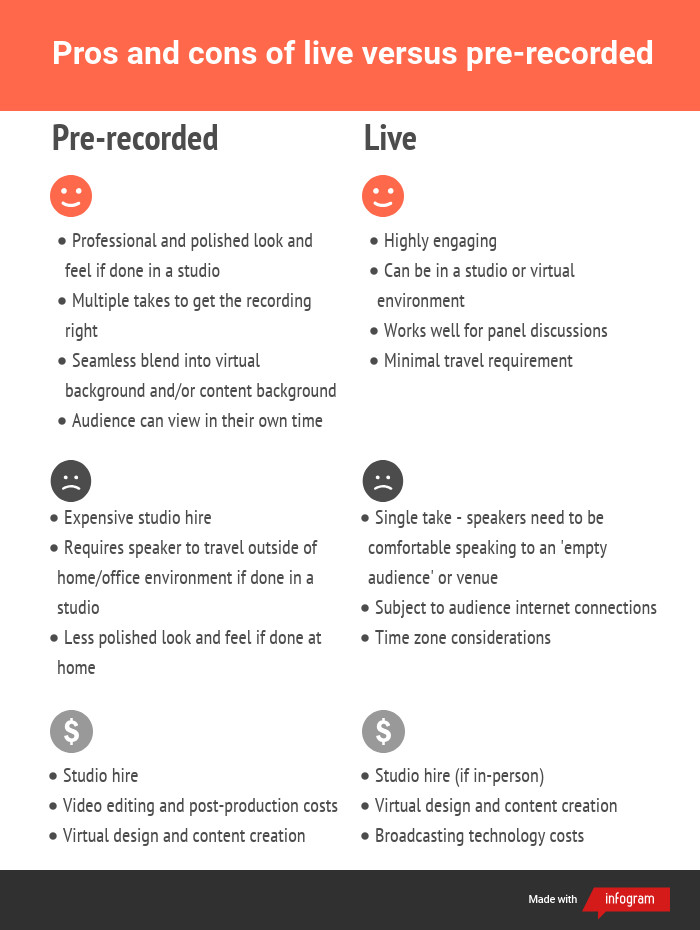
Image credits: Adobe Stock
-
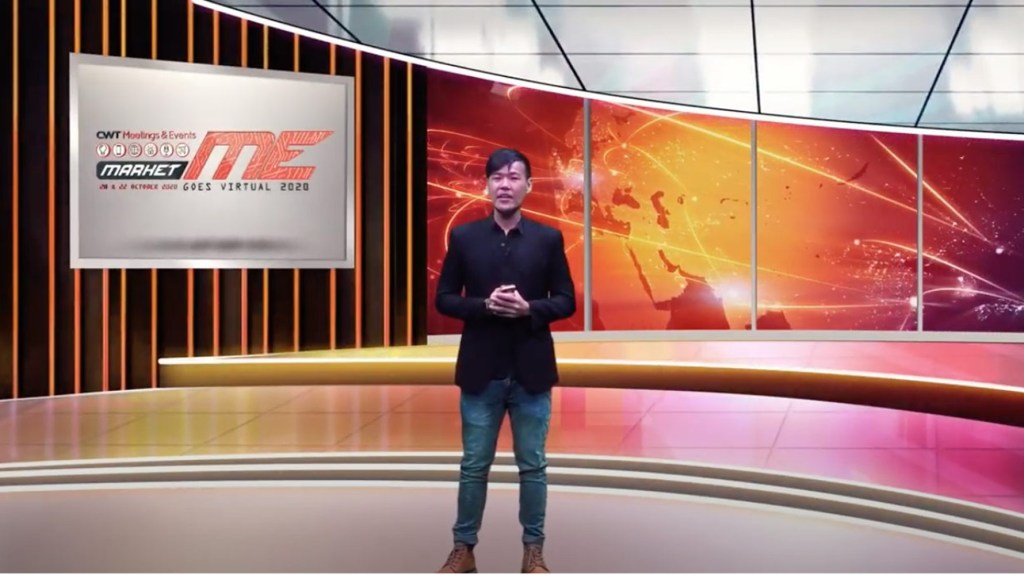
Rules of Engagement – 8 Steps to creating captivating and interactive virtual events
In September 2019, the CWT Meetings & Events (CWT M&E) team in Singapore held its inaugural MarketME event, providing a platform for buyers and suppliers in the industry to come together, exchange ideas and learn about the latest products, services, and trends in the market. The event itself was a showcase on how planners can break the mold of boring, stuffy corporate gatherings and instead create a festival-like atmosphere that increases attendee engagement. While the event was held in an upscale hotel ballroom, we replaced the conference-style seating with wooden crates, benches, and swing chairs. Supplier booths were designed to imitate the look and feel of a farmers’ market. And alongside the serious discussions taking place, there were games, entertainment, prize draws, and even a create-your-own cocktail station. Of the 118 attendees who participated, 94% gave the event a positive rating and every single one said they would return to attend the event the following year.
Then, just as we had started planning for MarketME 2020 with the intention of kicking things up a notch, COVID-19 happened. Government restrictions in Singapore forced us to move the event online. While virtual events have certain advantages – for example, they can cost less, allow you to reach a broader audience, and can be more eco-friendly – they aren’t a perfect substitute for face-to-face meetings. The biggest challenge, perhaps, is that it’s much harder to sustain people’s attention and form meaningful connections in a virtual setting. The change meant we had to completely re-think our event from start to finish.
After extensive planning and preparation, we held the 2020 edition of MarketME in October 2020 as a fully virtual event. We had 124 attendees from 26 countries participate in the forum.
Here are eight important things we considered in the process of organizing MarketME 2020, which might come in handy when you’re planning your next virtual event.
- Date & Timing
While MarketME 2019 was attended primarily by people based in Singapore, taking the event virtual this year gave us the opportunity to include participants from 26 different countries. However, this also meant we had to be cognizant of the various time zones, particularly as it was around the time of year when some countries change their clocks.
In our experience, mid-week days yield the highest turnout for corporate activities. Events held on Mondays and Fridays generally see lower attendance as people are either recovering from or preparing for the weekend. - Duration
Unlike physical events, virtual gatherings are not very conducive to long sessions (i.e. anything over 4 hours), as attendees tend to have a relatively shorter attention span due to the numerous distractions when interacting with their devices.
More breaks are needed to allow attendees to walk away from their devices and rest their body and mind in between sessions. - Format
In a virtual event, we can break away from a typical live event format that starts with an opening keynote, and instead dive straight into more interactive sessions that generate greater participation.
Keynote and content-heavy one-way presentations are not favorable for virtual engagement. On the other hand, live panel discussions, brainstorming, and other interactive sessions tend to work much better. - Virtual platform
The profile of the attendees, as well as the event objectives, will help determine which virtual platform may be most suitable. For example, for attendees who are less tech-savvy, a simple agenda-based platform could make it easier for them to find their way around.
Regardless, an easy to navigate platform with a clean and familiar design is always a good idea. You want to make it as simple as possible for the attendees to engage and interact with the content – and with each other. - Live vs pre-recorded sessions
Sessions that are broadcast live are naturally more exciting than pre-recorded ones, as attendees are watching the event take place in real-time. On the flip side, the event organizer may have to navigate various infrastructure and connectivity issues which could impact the seamless delivery of live sessions. For example, speakers may be located in countries where internet connectivity isn’t great.
To have the best of both worlds, you can consider a combination of live and pre-recorded sessions. Planning segments of the virtual event to have recorded content that can be accessed on-demand gives attendees greater control and flexibility in how they participate. - Bite-sized, visually appealing content & use of a green screen
Steer clear of wordy presentation slides – videos, infographics, and other visually-enticing content is the way to go.
The use of a green screen studio to deliver immersive content can also be fun and interactive. It allows you to place the presenter in a virtual environment that is related to the content they are sharing. - Gamification
Introduce an element of fun competition into your event by rewarding attendees based on their participation. Completion of quizzes, surveys, and worksheets to win points will keep attendees excited and looking out for more activities to participate in. Adding in a leader board can increase competitiveness between attendees and drive greater engagement. - Open networking
In a survey conducted by IAEE, PCMA, and The Experience Institute, three out of every four of the respondents stated that networking was one of the most important reasons for attending events.
Intimate connections are critical for any event where attendees wish to hold conversations between individuals or organizations. This is where relationships are fostered and opportunities are created.
Virtual networking goes far beyond video calls and text messaging, as instant document sharing, note- taking, and exchanging of contacts can be virtually executed.
- Date & Timing
-
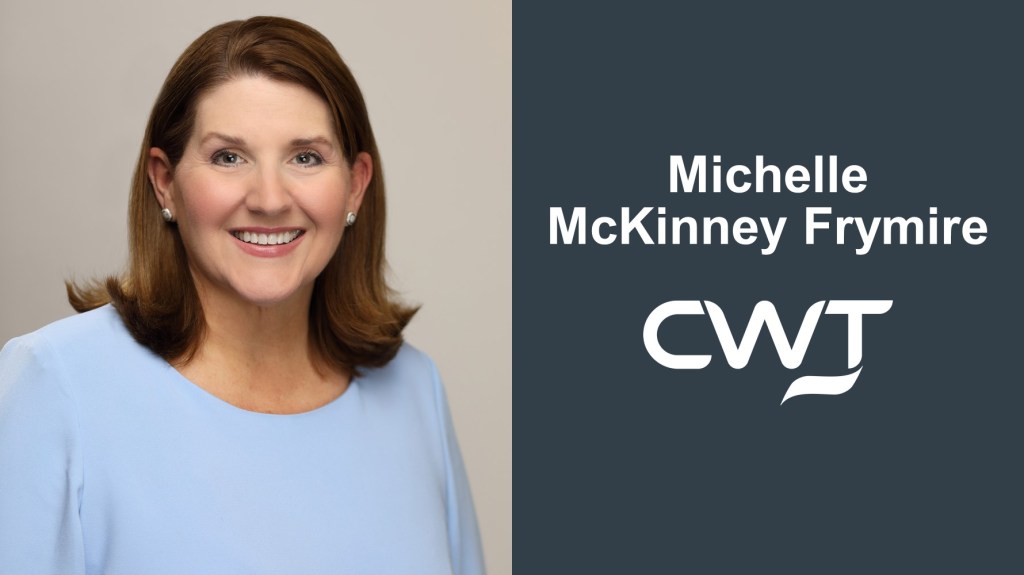
CWT announces the appointment of Michelle McKinney Frymire as Chief Executive Officer
CWT, the Business-to-Business-for-Employees (B2B4E) travel management platform, today announces the appointment of Michelle McKinney Frymire as Chief Executive Officer with effect from 1 May 2021. Incumbent Kurt Ekert will be stepping down and will take on the role of senior advisor to the company.
Michelle joined CWT in 2019 and has over 20 years’ travel industry experience. Her leadership has spanned a broad range of functions with notable leadership roles as the CFO at Starwood Vacation Ownership and Delta Technology (a division of Delta Air Lines), as well as Continental Airlines and Delta Air Lines. In addition, she held senior executive positions at several private equity portfolio companies where she led Strategy, Technology, HR, Corporate Development and Finance. Michelle currently serves on the Board of Directors for Family Gateway in Dallas, Texas and was appointed CWT’s President, Strategy & Transformation and Chief Financial Officer in October 2020. She holds a bachelor’s degree in economics from Austin College, and an MBA from the McCombs School of Business at The University of Texas.
“I am delighted to welcome Michelle to the role of leading our company into the next phase of our development, building on the successes of recent years*, and continuing to push us into achieving our true potential,” said Rick Gage, Chair of CWT’s parent company, CTII Holdings, Inc. “Following a strong and dynamic performance in her most immediate role as President, Strategy & Transformation and Chief Financial Officer, Michelle’s leadership skills will be key to our future accomplishments and continued development. As a natural development in our succession planning, I am also pleased that Kurt will remain an advisor to CWT, and I thank him for his leadership and impact.”
*Over the past five years, CWT has won approximately US$7 billion of new business, consistently grown market share, and built and scaled multiple, industry-leading offerings including RoomIt, follow-the-sun servicing, myCWT, messaging, and the China technology platform.
CWT is a leading global partner in business travel, meetings, and events. Operating across six continents, we deliver sustainable, tailored solutions that help organizations connect, engage, and thrive in an evolving world. Our myCWT platform integrates advanced technology with human expertise to simplify travel and enhance traveler and attendee experiences. Extensive global coverage, seamless data integration, AI-driven analytics, and carbon-conscious travel tools enable businesses to optimize their travel and meetings programs while delivering measurable value.
With 150 years of industry experience and a deep commitment to partnership, CWT collaborates with clients to shape the future of business travel and events, making them more efficient, responsible, and impactful.
-

Playing your part – 10 easy steps towards more sustainable meetings and events
here’s no denying virtual meetings have their advantages. You can circumvent travel restrictions and social distancing requirements, save money and create a smaller carbon footprint – all while sitting in your pajamas. And while they will likely remain a big part of how we do business moving forward, what’s become abundantly clear over the past year is that they aren’t a perfect substitute for face-to-face interactions.
As countries make progress with their vaccination campaigns and governments look at gradually easing restrictions, we’re seeing a lot of pent-up demand for in-person gatherings. In some places like Australia and Singapore, face-to-face meetings and events have already restarted, albeit with various safety measures still in place.
As we start to meet in person again, it’s important that we do so in a way that’s mindful of the environment. While meetings and events are an indispensable tool to drive business success, they can also result in large amounts of waste and carbon emissions.
The good news is that research suggests the pandemic has made consumers more eco-conscious, as lockdowns, travel restrictions, and reduced industrial activity have been linked with clearer skies, cleaner rivers, and better air quality in cities around the world. Meanwhile, in some instances, government bailouts for businesses—including airlines—have come with green strings attached.
When it comes to meetings and events, organizers and attendees alike have a role to play in promoting sustainable practices that will limit their environmental impact, while maximizing the lasting social benefits that they can leave on local communities.
Here are 10 easy steps that we should try and make part our “routine” when we attend meetings and events:
- Try to avoid printouts.
- Avoid all disposables, especially plastic: water bottles, coffee stirrers, etc.
- Recycle any trash you might produce.
- Do not over-heat or over-cool your hotel or meeting room.
- Remember to turn off lights, air conditioning, and heating when leaving your hotel or meeting room.
- Use tap or filtered water, instead of bottled water.
- Only accept goodies, flyers, etc. that you will truly use.
- Select vegetable, poultry, or plant-based alternatives over red meat dishes.
- Tell your hotel you wish to reuse bed linen and towels during your stay.
- Suggest a responsible team-building activity.
And of course, because change in an industry is fueled by customer demand, voice your preference for environmentally and socially responsible meetings and events whenever you are asked for feedback.
-

Is the sustainability movement in business travel here to stay?
The Covid-19 pandemic has created an emphasis on personal reflection and re-evaluation. Behavioral scientists talk about a shift towards authenticity and of congruence of personal values, actions, and work environment. Similarly, it forced organizations to reflect on their business model, with a drive towards sustainability that seems to have taken on a stronger sense of urgency than in the past. The idea of becoming more sustainable was present long before the pandemic but was viewed by many companies as an aspiration rather than a priority. Actions at a smaller level were taken but not necessarily at scale. This we now see clearly evolving: the pandemic has created not only a growing conscience towards a more sustainable approach but also a sense of urgency that wasn’t necessarily there before.
The stronger sustainability drive in society as a whole – with the effects of global warming becoming more visible, the ‘Greta effect’, Paris Agreement, and countries setting themselves ambitious carbon reduction goals – is gaining momentum in the business world too, both by intrinsic motivation and also by regulatory push. In 2020, we saw a growing number of companies adopt carbon reduction targets — an SBTi’s (Science-Based Targets ) analysis finds that the rate of adoption of science-based targets doubled in 2020 versus the period 2015-2019, with over 370 companies joining the SBTi in 2020 at an average rate of 31 per month in 2020.
This trend has led to a stronger need for emissions data in business travel, which would/can enable companies to make qualified decisions and make informed choices about what trips to book and with which modes of transport. At atmosfair we are seeing an evolution of carbon reporting requirements around 3 aspects:
- Requirements for more detail down to individual flight and supplier level, not just the total CO₂ footprint
- A need for real-time data: It is no longer enough to look at historical total CO₂ emissions. Real-time data enables travelers to make more informed decisions at the time of booking.
- A holistic approach to carbon reporting, making emissions data available alongside other relevant travel data in travel management dashboards – such as Average Ticket Price, Average Room rate, benchmarking information, and performance-versus-target.
As an NGO on a mission to make business travel greener, we are thrilled that awareness of sustainability is growing. At the moment, it has to take a back set behind pressing safety and health considerations until the Covid-19 pandemic is under control. Our hope and call to action for the business travel industry as travel returns is to ensure that sustainability considerations play a central role – and that its role will be here to stay. Remember that when the conditions of the pandemic have, hopefully, been overcome, carbon footprint will remain a lasting and increasingly relevant issue for business travel, and one that we must take action on now.
atmosfair is an independent non-profit organization specializing in making business travel greener. As an integrated service provider for carbon offsetting, atmosfair helps businesses measure, reduce, and compensate carbon footprint. Their advanced CO2 emissions calculations methodology is the best-in-class standard for emissions accounting in business travel. CWT Solutions Group travel consulting is powered by atmosfair reporting capabilities, helping our clients design and implement their responsible travel programs.
Image credits: Adobe Stock
- Requirements for more detail down to individual flight and supplier level, not just the total CO₂ footprint
-

Reimagining customer engagement: The importance of taking care of your client’s hotel content
According to a 2020 study by investpro.com, the likelihood of selling to an existing customer is 60-70%, while the probability of selling to a new customer is 5%-20%. So if growth is a primary corporate goal, then retaining clients is key. And what better way to achieve retention and loyalty than by raising the customer service bar and upgrading customer experience?
The pandemic has inevitably forced many to rethink the way they engage with customers. With many, including CWT, moving to an omnichannel approach and leveraging new, data-driven tech to maintain customer loyalty and trust throughout lockdown. This approach, combined with successfully communicating fast and effectively to increased (and understandably anxious) customer contact volumes, is the cornerstone to doing better business as we emerge from this crisis.
So what does this mean for corporate hotel sourcing organizations looking to further reshape their support systems, to fit seamlessly around customer’s needs and expectations, as travel begins to restart? ? Three words: Keep. It. Simple.
Travel and hotel management companies need to remain several steps ahead of their client’s hotel booking strategy, more so now than ever before by:
- Ensuring a client’s hotel content is loaded and ready for them to book.
- Having other content sources available for when a client property is unavailable.
- Providing additional content contracted, loaded, and available to keep the business traveler in channel and in compliance with their company travel policy.
- Having the agility to collect and pass relevant health, weather, and other safety updates to travelers in real-time.
Today’s business travel environment is changing month-to-month, and sometimes week-to-week. These circumstances call for the ability to dynamically display content taking policy, cost, geography, and experience into consideration. Having the right technology platform in place to support, organize and display multiple channel sources consistently is critical to retaining clients with unique program needs. One size does not fit all.
In many cases, the technology platform can only be effective when you have a truly strong process managing the content database. A strong repeatable process ensuring all hotel content and associated client preferencing is loaded, becomes foundational to any technology platform working effectively.
In the past, a TMC could rely on the business travel client to load hotel content in their online booking tool. This would support online bookings and offer some cover for any offline loading errors. If the goal is to achieve multi-channel display consistency, having one content management system is critical.
Now, machine learning can be pre-programmed to comprise multiple factors including policy considerations, experience, and cost.
Keep it simple; be ready to take the client’s hotel program in any format or frequency. Have a process that ensures loading and consistency across all relevant client booking channels.
Once we successfully load the system with client content and preferencing, are we done? Unfortunately, not. Programs change, properties change ownership, and contact information changes. Having strong systemic reporting and a process to correct any client content performing outside of the set tolerance is the final piece.
The future is here; machine learning can predict travel needs or be programmed to fit a client’s policy goals. However, best-in-class customer service only occurs when this kind of technology is accompanied by strong manual processes. Data still needs to be managed and maintained.
In a post-Covid world when adjustments may need to happen on the fly, great customer service combines expertise and industry knowledge with dynamic hotel content loading for real-time adaptability.
Image credits: Adobe Stock
-

Safer events with an enhanced certification for Covid-19 risk management

Objective
After a few months of working remotely due to the pandemic, a customer reached out to organize a live event as soon as local restrictions would allow it. Their sales team had been apart for too long. The customer wanted to plan a 1-day internal sales conference to present new products, turnover, and upcoming plans.
With 100 sales employees to re-engage and new products to put in the spotlight, the event also needed a solid visual identity and an engaging end-to-end communications plan.
Challenge
With few signs of live events becoming a possibility, CWT convinced the client that going virtual would be the best and safest choice. After agreeing, the client asked to keep costs down while having all nine speakers present live from a central location. They also requested support and best practices to avoid risks of Covid-19 infections.

We selected this event as the first to receive a new ISO certification for both pandemic risk management and sustainable event management: ISO 20121. On top of designing and managing the event itself, our teams had to drive all safety protocols while reducing the project’s sustainable impact to receive the certification.
Solution
With the triple objective of designing a successful event, reducing its environmental impact, and managing all safety protocols, our event planners got started by acting as the main point of contact between the client, speakers, and all the suppliers.
After specific site inspections in potential locations around the region, we quickly identified the client’s headquarters as the safest and most sustainable location to host nine speakers by avoiding the transfers of many across long distances.
Our event designers brainstormed with the client to better understand their goals, attendees, and expectations. It became clear that to reach the client’s objectives, the event needed to stay on the “serious” side with sessions on products and business strategy. It also required a good balance of entertainment and positivity with attendees being apart for so long. We created a future-oriented creative event theme that became the basis for all communications, including digital visuals and presentations. We also put together a care package, fully branded with the event theme, to send to each attendee containing locally sourced gifts and a creative cocktail kit.
To comply with local Covid regulations and receive the certification, our teams reviewed the protocols of every supplier, as well as the client’s ones. We set up new forms and approvals, on-site protocols to limit the risks of infections such as social distancing, individual microphones, and micro-bubbles to avoid mixing different groups.

Results
Protocols were respected at all times: speakers kept fixed distances on set, with never more than three at once on stage; sanitation procedures were followed; our staff and director stayed in separate rooms, and bubbles didn’t mix. No infections were reported.
All requirements were met to receive the official Covid-compatible and sustainable event accreditation – a first for the client and CWT!
Speakers and attendees reported excellent communications and coordination. They gave highly positive feedback, mentioning that the digital format did allow them to reach their objectives.

Quick facts
- Received a novel certification: ISO 20121 for pandemic risk management and sustainable events
- No infections were reported
- 45% cost saving by going virtual
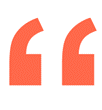
“Congratulations on the fantastic organization of this UNIQUE EVENT”
“Thanks to everyone and congrats for the excellent organization!”
“Virtual applause”
-
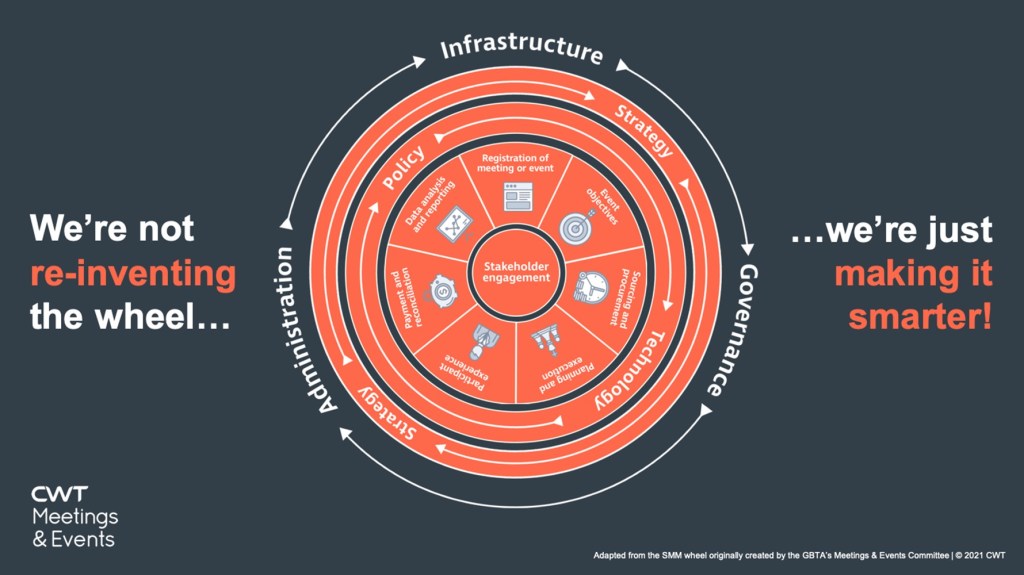
Strategic Meetings Management: Why now is the time to think outside the wheel
Albert Einstein said it best: “In the middle of every difficulty lies opportunity.” While, to a large extent, business travel and in-person meetings and events remain on hold, many companies are recognizing that this is a great time to establish – or fine-tune – their Strategic Meetings Management programs.
Strategic Meetings Management (SMM), as the name suggests, is a disciplined approach to managing meetings and events across an organization. It can help businesses achieve many objectives, from managing costs to mitigating risk and creating a better experience for meeting organizers and attendees.
You may already be familiar with the SMM Wheel, created by the Global Business Travel Association’s (GBTA) Meetings & Events Committee, representing the best-in-class standard for managing an enterprise-wide meetings and events program. While the wheel’s 11 components are essential to building an effective SMM program, there is a question that remains: can these components alone help you reach your goals? Over the years, many M&E leaders and practitioners have discovered gaps despite using the wheel as the foundation for their SMM programs. These gaps can include difficulty building a business case with senior leadership, gaining stakeholder buy-in, and ultimately driving adoption for the program across the organization.
With more organizations taking the necessary steps to centralize their meetings and events, I would argue that now is an excellent time for us to start “thinking outside the wheel.” The wheel provides an excellent framework, and we don’t necessarily want to reinvent it – but we need to find ways to make it smarter, to reach its full potential. We have narrowed this down to three guiding principles:
- Infrastructure – Just as a car needs roads and bridges to get to its destination, it’s critical to have an organizational structure that supports the SMM program across your enterprise to help you achieve your goals. This infrastructure encompasses the funding model, resource model, service configuration, technology, and suppliers that you should include as part of your program. These are essential considerations to incorporate before implementing any or all 11 components on the wheel. Feedback from stakeholders will provide insights and answers to several of these questions and help create a strategy around the three guiding principles.
- Governance – If Infrastructure is the roads and bridges, then Governance is the GPS that provides direction. There needs to be oversight of the program to drive change and adoption. It can be done in a mandated or non-mandated environment. The oversight follows the direction of the corporate culture and objectives to align with the business goals. This supports the policy, compliance, resources, processes, and services associated with your SMM program.
- Administration – Continuing with our motoring analogy, this is where the rubber meets the road. Administration is the maintenance required to keep the car up and running. It’s the day-to-day operation and support required to execute the SMM program. It drives demand management strategies and ensures a consistent interpretation of policies and processes such as the intake of registered meetings, maintenance of the technology, the service workflow to maintain fair and balanced resources, supplier market share, continuous process improvement, and training. A lead agency model also plays a vital role in extending the SMM program’s internal team. This model establishes some centralized services while allowing stakeholders the flexibility and choice of planning services.
Including these guiding principles alongside the SMM wheel’s components will establish what is needed to set a clear path forward and help your SMM program quickly gain momentum towards full adoption.
What’s more, this approach can (and should) be applied to all meetings across your organization. There is a perception that SMM only includes certain meeting types. Very often, small, virtual, hybrid, executive, and sponsorship meetings, as well as congresses and healthcare professional (HCP) meetings in the life sciences sector, are left out of SMM programs. SMM is evolving to include the totality of all meetings and events activity. At CWT Meetings & Events, we see this evolution as what we refer to as Total Meetings Management (TMM). TMM is the future of SMM. Want to hear more? Look for our next blog, where we will explore TMM in more detail.
New to SMM and want to learn more, have an existing SMM program but don’t have the adoption you were hoping for, or maybe you are looking to expand into new markets? We can help! Contact our SMM Consulting Solutions Team for more information.
Image credits: CWT
-

Clean switch: How to have a successful workation
Call it a workation, a woliday or anything you like, the pandemic has led to a rise in popularity in trips that combine work and pleasure, with 74% of remote workers saying they’d consider taking one, according to research company Axios.
We sent a poll out to our just under 200,000 LinkedIn followers and found a whopping 60.5% of those surveyed cited the uniqueness or attractiveness of a destination as the most influential factor in deciding to take a workation.
But like the targeted ad I just received for Studio 54-inspired glittery sweatpants for at-home Zoom parties (surely Bianca Jagger wouldn’t have worn an elasticated tracksuit?) it’s clear that not everything blended is for the better.
Some proponents of bleisure trips believe they’re great for boosting morale. Others believe that combining work and play can lead to burnout. If you’re excited to return to travel and intent on combining a sales meeting with a tour of the Acropolis, here’s how to get the best out of your time.
- Switch off completely
In the battle against information overload, exacerbated by the pandemic and reliance on screens, it’s important to take time to fully switch off. “Don’t let the feeling of false progress fool you,” says Jocelyn Glai, author of ‘Unsubscribe,’ “When we put off doing important tasks by opening each email message at the moment it arrives we’re tricking our brain. It triggers the same response we get from accomplishing an important task.” - Schedule longer blocks of time to explore
To truly get the best out of your time, it’s best not to steal hours here and there but book an entire day or at least half a day to vacation. Work engages your responsible, strategic, intelligent adult mind. To reap the cognitive benefits of the leisure aspect of your trip, try and remember what you loved doing as a child, identify the most important aspect and find the adult version, approached with childlike wonder. If you liked building as a kid, you might explore an amazing feat of engineering in a new city. If you liked adventure, hire a bike and get lost in a new place. - Plan ahead
Reduce the mental load and potential strain on productivity by packing well (including portable chargers and backup hotspot), sending detailed handovers to colleagues back at home and making sure you have everything you need with our Travel Essentials tool.
Image credits: Adobe Stock
- Switch off completely
-

Life science spotlight: 5 trends impacting corporate travel programs
The pandemic has impacted the corporate travel programs of almost every industry across the globe. The Life Science industry – comprising pharmaceuticals, biotechnology, medical devices, and biomedical technologies companies – will be more in the spotlight than ever in 2021 as we continue to navigate the first major global pandemic of this scale since the emergence of modern life sciences.
In my view, supported by consultants including PWC and Pharmaboardroom, we’re seeing changes in the industry that will impact the future travel programs of life science companies:
- Affordability and accessibility
2020 was about the race to develop vaccines. 2021 will be about how to deliver those vaccines to the world’s population, especially in developing countries. The production and distribution of vaccines are critical to returning to travel in the life science marketplace. - Transparency
There has been more focus on transparency when it comes to the pricing of medicines and vaccines. There’s a clear parallel in the corporate travel market where travel management companies (TMCs) and life science companies are looking for alternative pricing models to accommodate these changing needs. Given the uncertainty of how fast corporate travel will bounce back in life sciences, scalable pricing models that support growing and changing demand are key. As travelers look for more in-depth health and security information through various channels such as messaging, TMCs and customers need to work closely together to co-create their price models to meet the needs of life science companies. As such, data transparency has become an essential component in making the right decisions. - Supply & supply chains
The wealthiest nations are ahead in securing the majority of the first available supplies of vaccines. To ensure a fair distribution on a global level it is vital to achieving a good balance between how to operate and collaborate with other suppliers in the market. The same applies in the corporate travel world where collaboration with suppliers is key in bringing relevant information, such as health & destination information, directly to travelers via the supply chain, so they can make an informed decision whether to travel. - Environmental Social Governance (ESG)
The notion that companies have a responsibility to serve the broader community on an equal level as their shareholders is fast becoming the accepted norm. How life science companies respond to this and adapt their own business models will become even more important in 2021. From a travel management perspective, customers are looking for more real-time and end-to-end data, including virtual meetings & events data. Life science customers are subject to transparency regulations such as the Sunshine Act in the US. Together with health care professionals, these companies need to be able to report on very specific travel spend items to comply with regulations and avoid penalties. As travel has shifted from in-person to virtual meetings, companies are looking for data on transient and (virtual) meeting and events spend. TMCs like CWT can deliver such data to provide business essential insight to customers, enabling them to be compliant and cost-effective. - Digital technologies
The life sciences industry has had to pivot and adopt new ways of working. To varying degrees, companies have been reluctant to embrace technology. But when challenged to do so by COVID-19 they discovered that it worked. Life Science companies have been talking about ‘adaptability’, ‘flexibility’ and ‘disruption’, and now, with digitalization at warp speed, they had to adapt, in a much faster way than they could have imagined. Life science companies and their employees are looking for support through the entire travel journey. From real-time, relevant booking information, such as health requirements and local government regulation, to real-time travel data to ensure the company can comply with duty-of-care.
Life science companies must be aware of the broader business, economic, social, and political forces that shape the external business environment around them and develop their corporate travel strategy in response to these forces. Companies can adapt their corporate travel strategies by taking a holistic approach and balancing duty-of-care with economic rationales, now more than ever before.
Image credits: Adobe Stock
- Affordability and accessibility
-
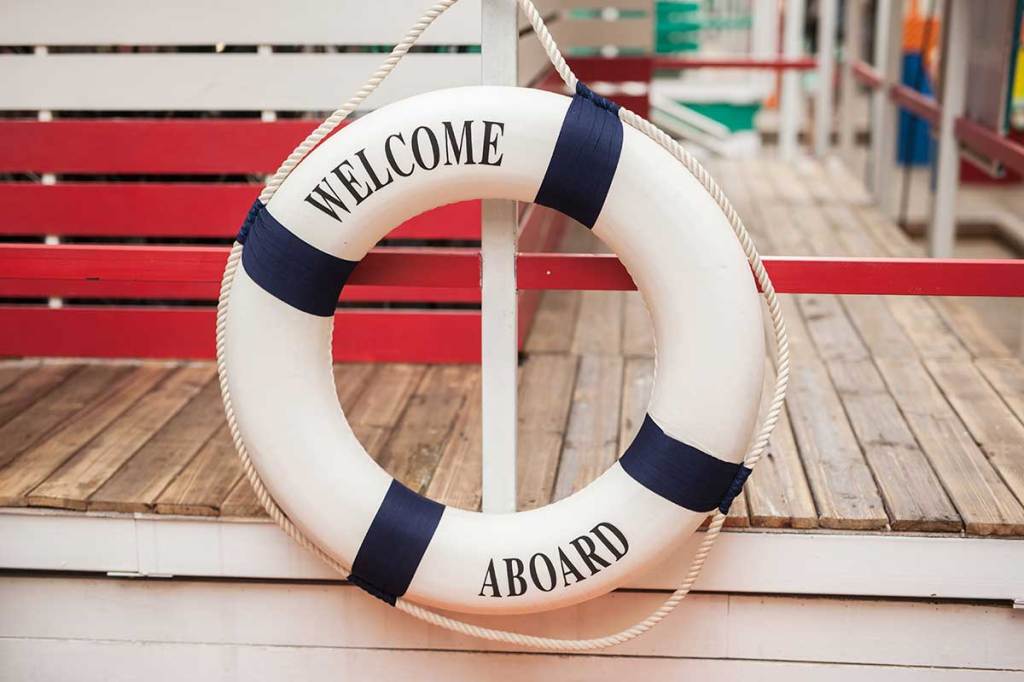
7 steps to seamless onboarding
The onboarding process can be a headache for clients. With strict deadlines to meet, technical solutions to communicate, and stakeholder expectations to manage, the implementation process can feel like an impossible task before it has even begun.
Yet it’s of utmost importance to make the process as smooth as possible and familiarize new clients with your products and services. If you successfully onboard a happy new customer they will refer you to other clients. According to the marketing company, Wyzowl 86% of people say they’d be more likely to stay loyal to a business that invests in the onboarding process.
Throughout the COVID-19 pandemic, CWT maintained a heavy focus on the client onboarding experience, by leveraging Webex versus face-to-face meetings, optimizing resources through global load-sharing, and adapting to client’s availability and priorities, resulting in a 2020 NPS score of 57, a world-class score* considering the average for the travel industry is 18.
Here are 7 essential steps to ensure smooth onboarding. It all boils down to strong communication throughout every phase.
- Scope of the project
Although it seems like the most logical first step, onboarding can descend into chaos if goals are not defined from the outset and there is uncertainty about who is responsible for what. It’s critical to start with a clear definition of the project and a well-defined scope. Make sure you know the what, when, where, and how of onboarding. - Discovery workshops
To foster a deep understanding of your client’s needs consider organizing workshops. If you talk to people on different levels within the organization you will get a better view of what needs to be done to connect the dots. - Regular project updates
Make sure you keep everyone involved, informed, and aligned by giving project updates on a regular basis. If a risk arises that impacts the implementation process, you can use these project updates to communicate and mitigate problems. - Change management
Support your customer with their internal change management process. For successful onboarding, it is vital that all stakeholders are informed and aligned. - User test phase
Before you sign off the test phase, make sure that you validate that the system works as agreed. Go through every step and detail with the client to iron out any concerns. - Successful handoff
Don’t cut the cord as soon as your client has been onboarded. Stay connected and support them with excellent service and a professional customer team for the long term. - Evaluate
Make use of your clients’ feedback during and after implementation. Both positive and negative feedback will support continuous improvement.
CWT used these steps to refine our implementation process with standardized global processes and governance to deliver the smoothest transition possible. “First impressions are lasting impressions,” after all.
*Satmetrix NPS Benchmark
Image credits: Adobe Stock
- Scope of the project